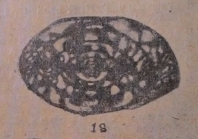
| Intro | | About | | Wiki | | Search traits | | Data explorer | | Literature | | Definitions | | Sources | | Webservices | | Statistics | | Feedback | | Editors | | Log in |
Foraminifera name detailsDutkevichella Putrya, 1956 †
721803 (urn:lsid:marinespecies.org:taxname:721803)
alternative representation (The main difference between Dutkevichella and Hemifusulina lies in the wall structure which is still under discussion (see note below))
Genus
Fusulina dutkevichi Putrya, 1938 † accepted as Hemifusulina dutkevichi (Putrya, 1938) † (type by original designation)
marine,
fossil only
feminine
Putrya, F. S. (1956). Стратиграфия и фораминиферы среднекаменноугольных отложений Восточного Донбасса. В кн.: фораминиферы, мшанки и остракоды Русской платформы, Донбасса, Тенгизской впадины и Кузбасса - Stratigraphy and foraminifera from Middle Carboniferous deposits of the Eastern Donbass. In: Foraminifera, bryozoans and ostracods of the Russian platform, Donbass, Tengiz basin and Kuzbass. <em>Микрофауна СССР - Mikrofauna SSSR, Trudy Vsesoyuznogo Nauchno-Issledovatel'skogoGeologorazvedochnogo Instituta VNIGRI.</em> 8(98): 333-485., available online at http://www.geokniga.org/books/18140
page(s): p. 460 [details] Available for editors
Taxonomic remark The main difference between Dutkevichella and Hemifusulina lies in the wall structure which is still under discussion;...
Taxonomic remark The main difference between Dutkevichella and Hemifusulina lies in the wall structure which is still under discussion; either diaphanothecal (and as a consequence, Hemifusulina has priority upon Dutkevitchella and Hemifusulinella); or keriothecal (and in this case Hemifusulina has priority upon Darvasites (Alpites) Davydov, Krainer and Chernyk, 2013). The taxonomic problem is therefore complicated. Vachard (2018) pers. com. [details]
Hayward, B.W.; Le Coze, F.; Vachard, D.; Gross, O. (2025). World Foraminifera Database. Dutkevichella Putrya, 1956 †. Accessed at: https://www.marinespecies.org/foraminifera/aphia.php?p=taxdetails&id=721803 on 2025-05-16
Date action by
original description
Putrya, F. S. (1956). Стратиграфия и фораминиферы среднекаменноугольных отложений Восточного Донбасса. В кн.: фораминиферы, мшанки и остракоды Русской платформы, Донбасса, Тенгизской впадины и Кузбасса - Stratigraphy and foraminifera from Middle Carboniferous deposits of the Eastern Donbass. In: Foraminifera, bryozoans and ostracods of the Russian platform, Donbass, Tengiz basin and Kuzbass. <em>Микрофауна СССР - Mikrofauna SSSR, Trudy Vsesoyuznogo Nauchno-Issledovatel'skogoGeologorazvedochnogo Instituta VNIGRI.</em> 8(98): 333-485., available online at http://www.geokniga.org/books/18140
page(s): p. 460 [details] Available for editors basis of record Loeblich, A. R.; Tappan, H. (1987). Foraminiferal Genera and their Classification. Van Nostrand Reinhold Company, New York. 970pp., available online at https://books.google.pt/books?id=n_BqCQAAQBAJ [details] Available for editors From editor or global species database
Taxonomic remark The main difference between Dutkevichella and Hemifusulina lies in the wall structure which is still under discussion; either diaphanothecal (and as a consequence, Hemifusulina has priority upon Dutkevitchella and Hemifusulinella); or keriothecal (and in this case Hemifusulina has priority upon Darvasites (Alpites) Davydov, Krainer and Chernyk, 2013). The taxonomic problem is therefore complicated. Vachard (2018) pers. com. [details]
|
